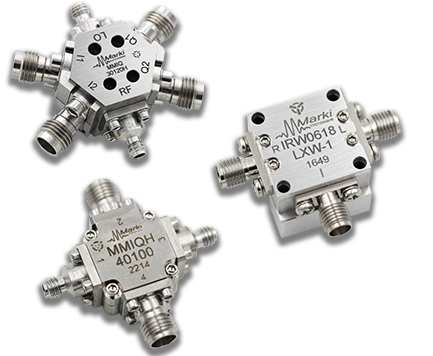RF Mixers vs. IQ Mixers: Features, Applications, and Key Differences
RF mixers are essential components for communication systems, enabling efficient frequency conversion and signal processing. Two categories of mixers include RF Mixers and IQ Mixers.
RF Mixers
1. MMIC (monolithic microwave integrated circuit) Double Balanced Mixers
These mixers offer exceptional conversion loss, isolation, and spurious suppression across a frequency range of 1 GHz to 120 GHz. They are ideal for high-frequency applications requiring excellent signal integrity.
2. T3 High Linearity Mixer
As an advanced design with broad overlapping RF, LO (local oscillator), and IF (intermediate frequency) bands and high linearity, these mixers are suitable for sophisticated communication systems where distortion must be minimized.
3. Triple Balanced Mixers
These mixers provide overlapping bands, enhanced linearity, and improved spurious suppression. Hence, they are effective in applications that demand high precision and low noise.
4. Integrated Drive Mixers
These mixers combine high-performance mixers with an LO driver amplifier in a compact package. This makes them perfect for space-constrained environments, simplifying system design.
5. Harmonic Mixers
These utilize LO harmonics for frequency conversion, especially when high-frequency LO sources are unavailable. They provide versatility in various RF applications where flexibility is needed.
6. Legacy Mixers
The mixers provide lower conversion loss and high isolation, making them suitable for legacy systems and laboratory use. They also offer reliability for applications requiring broad bandwidth despite some sacrifices in image rejection and balance.

IQ Mixers
1. Double Balanced IQ Mixers
Offering excellent balance for enhanced image rejection and sideband suppression, these mixers are useful in applications needing high fidelity in signal processing.
2. Differential IF IQ Mixers
High-performance mixers with differential I/Q (In-phase (I) and Quadrature (Q)) ports for straightforward integration. These are ideal for systems that require a direct interface with differential circuits.
3. Single Sideband Mixers
Upconvert signals to a single sideband while effectively suppressing the other sideband. Optimized for communication systems needing efficient sideband management.
4. Legacy IQ / IR (Image Rejection) / SSB (Single Sideband) Mixers
These mixers provide lower conversion loss than MMICs but sacrifice some image rejection and balance. They are suitable for legacy systems where cost-effectiveness is important.

Differences
In terms of their purpose, RF Mixers are typically focused on general frequency conversion and signal processing, while IQ Mixers are designed specifically for in-phase
and quadrature signal processing.
Considering their architecture, RF Mixers can include various designs (like double-balanced and triple-balanced), whereas IQ Mixers are generally structured
for optimal I/Q balance and sideband suppression.
Integrated Drive Mixers are a unique feature of RF Mixers, combining mixers with LO drivers, while IQ Mixers emphasize differential connectivity.
Similarities
In terms of functionality, both categories serve the essential purpose of frequency conversion and signal processing.
Both can be employed in communication systems, though the specific application may differ based on the requirements for linearity, balance, and signal fidelity.
Based on their performance metrics, both types consider important performance characteristics such as conversion loss, isolation, and linearity, although the emphasis may vary.
—
Understanding the distinctions and commonalities between RF and IQ Mixers is crucial for selecting the appropriate components for your specific projects.
Whether you require high-performance RF mixing for general applications or specialized IQ processing for advanced communication systems, Marki Microwave offers a comprehensive range of these mixers tailored to meet various requirements.
Their innovative designs ensure exceptional performance in terms of linearity, isolation, and conversion loss, making them ideal for both commercial and military applications.
Marki Microwave’s mixer technology achieves reliable and efficient signal processing, ensuring your systems operate at their best.